
LEFKANDI-XEROPOLIS 2003 SEASON
East Sector
In the East Sector structures and walls were concentrated in the region
around Trial W, excavated in 1965. The poor quality Early Iron Age walls
within this Trial were removed in its original excavation, the N/S line
of one such wall was followed intermittently further north beyond its
edges. It appears to provide a western limit to the structure which is
now called the East House. An eastern limit to the same structure may
be surmised by the presence of two pits of Protogeometric/Sub-Protogeometric
(PG/SPG) and Late Geometric (LG) date, some 5 m away: such pits must having
been dug outside the building.
 |
A second structure, the West House, just to the west of the first, is indicated by what appears to be flimsy walling. Interestingly, a longer period of occupation in this region could be attested here if walls and related levels belong to the EIA. If further excavation supports such an assumption then houses from more than one chronological phase will have existed in this area.
The East and West buildings seem at present to be rectangular, but they are incomplete. Their size as preserved is at least 4–5 m in length, with their long axis running N/S. To judge from associated soil and finds, their dates are Sub-Mycenaean (SM) or Early Protogeometric (EPG).
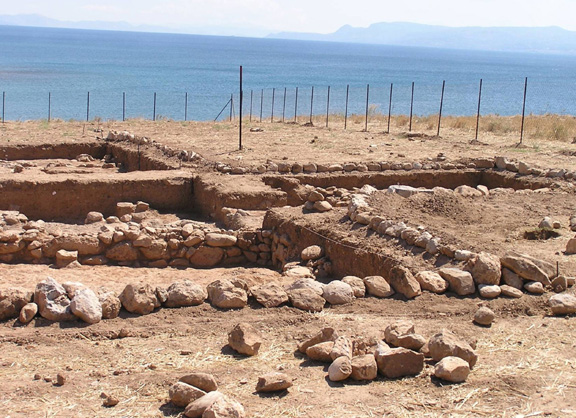 |
| The
East Sector during excavations in 2003 |
Just west of the north limits, as excavated to date, of Wall 6, an almost complete amphoriskos of SM/EPG date was recovered (only part of its neck is missing). This is an unusual find to have in a settlement since such a vase shape is usually given as a grave offering. Therefore an intriguing possibility is held out that this vase belongs to a burial, although no bones were found. Since children’s bones are often not preserved and child burials near settlements are not uncommon in the period, it might have been a infant’s. Another vase recovered in the area was also complete: a small jug. Its date is the same as the amphoriskos and it could even belong to the same putative burial. As important, and clearer, is the fact that their presence underlines the use of the area during the crucial transition period from the Late Bronze to the Early Iron Age, providing evidence of occupation on Xeropolis during this stage.
A further point of interest is the apparent continuity in the use of space in this area between the latest Late Helladic IIIC (Lefkandi, Phase 3) and the EIA habitations. First, the EIA walls often run close to or even on the Mycenaean, observing the same approximate orientations. The gap between two Mycenaean houses here was utilized as a N/S alleyway made of pebbles in grey soils and it too seems to have retained its use in the EIA times. Secondly the use of the two pits in the eastern limits during PG/SPG and LG also points to longer occupation and activity in the area.
Preliminary Pottery Report 2003 – East Sector
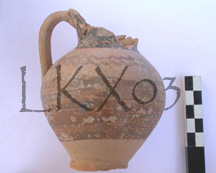 |
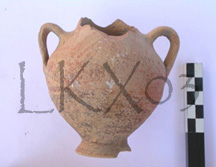 |
Amongst the most exciting discoveries in this sector are those of the two almost complete vases associated with walls which belong stratigraphically to the period after the end of the Late Helladic IIIC period. They consist of an amphoriskos and jug. Their date is SM/EPG with good parallels from similar vases found in the Skoubris cemetery.
Good quality Early Iron Age Pottery was found in Pit 1.
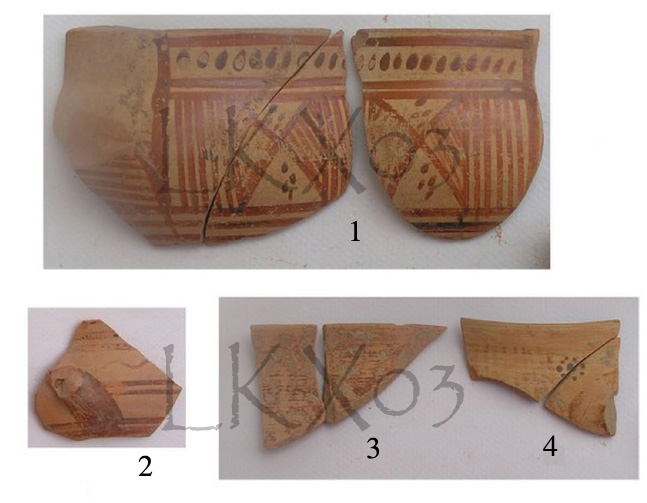 |
1: Late Geometric skyphos with dashes on the rim and cross-hatched triangles in the handle zone; 2: skyphos with banded lip and wavy line; 3: monochrome painted crater rim; 4: Late Geometric banded skyphos with dotted rosette.
 |
5-6: PG/SPG rim from zigzag cup; 7: skyphos with hatched bird on the body; 8: fragment from the body of pendent semicircle skyphos; 9: fragment of SPG III (Middle Geometric Atticising) skyphos; 10: Late Geometric skyphos with dashes on the rim; 11–12: fragments of Late Geometric pyxis with ?bird in a panel.
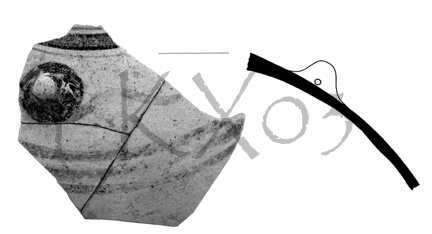 |
A good amount of Late Helladic IIIC
pottery (Lefkandi-Phase 3 or perhaps late Phase 2b) with some good examples
of the so-called ‘White Ware’. Illustrated is a fragment from
a closed vase perhaps from a belly amphora or amphoriskos decorated with
bands and a ‘nipple’.
Home > New Excavations >2003 Season > 2003 West Sector>2003 Season East Sector>2004 Season